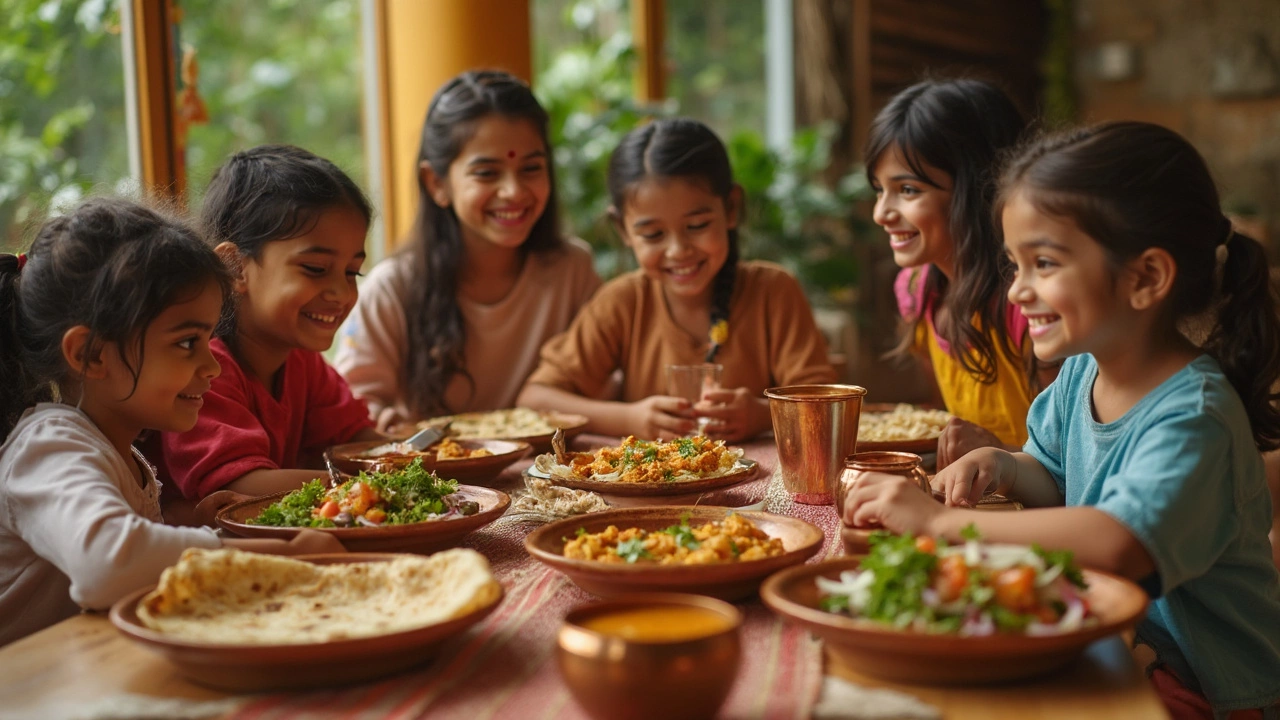Tikka masala always seems to pop up on every Indian food menu—creamy, orange, and honestly, impossible to resist. But is it anywhere close to healthy? Right off the bat, it’s common to picture tikka masala swimming in a silky sauce, often with juicy pieces of chicken or paneer. That sauce? It usually gets its richness from cream, butter, or ghee.
But here's the kicker: that dreamy flavor comes with a calorie punch and a good amount of saturated fat. Restaurants love to go heavy on the oil and cream. If you’re grabbing tikka masala as a snack thinking it’s a lighter option, it pays to take a closer look at what’s actually inside your bowl.
- What’s Really in Tikka Masala?
- How Nutritious Is Tikka Masala?
- Healthy Swaps and Cooking Tips
- Is Tikka Masala a Smart Snack Choice?
What’s Really in Tikka Masala?
If you’ve ever wondered what gives tikka masala that rich, bold flavor, it’s all about the ingredients. The classic recipe starts with marinated chunks of chicken (or sometimes paneer for a vegetarian spin), grilled or roasted and then dunked into a hot, creamy tomato-based sauce. This isn’t some random combo—they each play a role in the taste and texture.
- Protein: Almost always chicken breast or thigh, sometimes swapped with paneer or veggies.
- Yogurt: Used in the marinade for tenderness and a tangy kick.
- Spices: Garam masala, cumin, coriander, turmeric, chili powder, and fresh ginger and garlic are almost standard.
- Tomato Sauce: Pureed tomatoes create the main sauce base, making it vibrant and tangy.
- Cream or Butter: This is where it gets heavy—restaurants often use a good bit of cream, butter, or ghee to get that thick, velvety texture.
- Onions: These help build flavor and body in the sauce.
Here’s something you may not realize: the version you get in restaurants can have double—or even triple—the amount of cream and oil compared to homemade versions. That’s why homemade tikka masala is usually lighter and doesn’t leave you feeling like you need a nap after.
| Ingredient | Common Amount Used (per serving) |
|---|---|
| Chicken | 100-120g |
| Cream | 2-4 tbsp |
| Butter or Ghee | 1-2 tbsp |
| Tomato Puree | ½ cup |
| Spices | 1-2 tsp (mixed) |
| Yogurt (marinade) | ¼ cup |
If you make tikka masala at home, you can swap out cream for Greek yogurt or coconut milk, and cut back on the butter. That makes it way better for you, but still totally satisfies your Indian food cravings. Next time you wonder about what goes into this dish, just remember—what’s in it depends a lot on who’s cooking it.
How Nutritious Is Tikka Masala?
So, where does tikka masala really stand in the world of nutrition? Breaking it down, most classic recipes mix grilled chicken or paneer with a sauce loaded with tomatoes, onions, butter or ghee, heavy cream, and a fair amount of spices. The protein is a win—chicken tikka is actually a pretty lean choice before it dives into the sauce.
But things change fast with the additions. The sauce packs in calories from cream, butter, or even cashews, depending on who’s cooking. One restaurant serving can run you anywhere from 400 to 700 calories, and sometimes higher if you’re getting extra sauce or naan on the side. Fat content can be 30 grams or more, mostly from saturated fats, which isn’t doing your cholesterol any favors if you eat it all the time.
Want something more practical? Here’s a quick snapshot of what you might find in a standard chicken tikka masala serving (about 1 cup):
| Nutrient | Amount |
|---|---|
| Calories | 430 |
| Protein | 28g |
| Total Fat | 31g |
| Saturated Fat | 16g |
| Carbs | 16g |
| Sodium | 1320mg |
You do get good protein, and tomatoes and spices deliver a nice hit of antioxidants. But the high fat and sodium content? Not great for daily snacking. If you’re watching your calories or heart health, you’ll want to keep portions in check or rethink how you make it.
If you swap the cream for low-fat yogurt or coconut milk, you’ll slice down those numbers big time. But traditional tikka masala—especially as served in restaurants—is usually more of a treat than a healthy staple.

Healthy Swaps and Cooking Tips
If you want to keep tikka masala on your snack list without overloading on calories and fat, you just have to tweak the usual recipe a bit. Here’s how to make it work when you’re aiming for a healthier plate:
- Go easy on the cream: Swap heavy cream for low-fat yogurt or even plain Greek yogurt. You’ll still get that smooth texture, but without as much saturated fat.
- Skip the butter: Olive oil or a small dab of light butter can stand in for ghee. You only need a splash to bring in flavor.
- Use lean proteins: Chicken breast is the go-to, but tofu or even chickpeas work if you’re skipping meat. Paneer is delicious, but try grilling it instead of frying to cut down on unnecessary oil.
- Pump up the veggies: Toss in bell peppers, spinach, or peas. They add vitamins, fiber, and make your healthy Indian snacks feel more filling.
- Watch the salt: It’s really easy to go overboard. Use spices for punch—cumin, coriander, and paprika do wonders without adding sodium.
If you want to see how things stack up nutritionally, here’s a quick comparison for a typical restaurant version vs. a lighter homemade one (per serving):
| Restaurant Tikka Masala | Lighter Homemade Tikka Masala | |
|---|---|---|
| Calories | 450-600 | 250-350 |
| Saturated Fat (g) | 12-18 | 4-7 |
| Protein (g) | 22-28 | 20-27 |
One more thing: portion size makes a big difference. Even a healthy version can blow your snack goals if you go overboard, so serve in small bowls or pair it with a salad to balance things out. Prepping extra tikka masala also makes meal planning easier—you can freeze portions and reheat later, which beats last-minute takeout.
Is Tikka Masala a Smart Snack Choice?
If you’re reaching for tikka masala as a snack, you might want to pause and think about what you’re getting. Traditional tikka masala has a reputation for being more of a meal than a snack. The truth? It’s pretty filling and, depending on how it’s made, often loaded with calories and saturated fat, especially when heavy cream and butter take center stage. A typical restaurant serving (about one cup) can pack over 350–450 calories and close to 25 grams of fat. If you scoop it up with naan or rice, the numbers climb fast.
Here’s a snapshot of what a typical chicken tikka masala might look like nutritionally:
| Nutrient | Amount (per 1-cup serving) |
|---|---|
| Calories | 380 |
| Protein | 24g |
| Fat | 25g |
| Saturated Fat | 11g |
| Carbs | 15g |
| Sodium | 900mg |
Now, those numbers don’t scream “healthy snack,” especially if you’re trying to keep things light between meals. That said, there are ways to make tikka masala smarter and more snack-friendly. A few tips?
- Keep your portion small—half a cup can satisfy a savory snack craving without overdoing the calories.
- Choose homemade or lighter versions with less oil, cream, or butter, and bulk up your plate with veggies.
- Swap out chicken for paneer or tofu if you’re plant-based, but watch out for the fat content.
- Avoid heavy sides like naan and rice if you’re just after a snack. Try cucumber sticks or whole-grain crackers instead.
Bottom line, tikka masala isn’t the healthiest Indian snack on its own, but if you pay attention to ingredients and portions, you can enjoy it without blowing your healthy eating goals. When you treat it more like a treat than an everyday snack, it fits into a balanced diet just fine.
